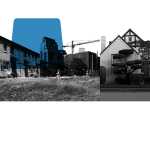The Denver Public Housing Authority has developed and implemented an innovative plan to address a major driver of health inequities: a lack of stable, affordable housing in a fast-growing city. With the Mariposa redevelopment project, DHA let community input and residents’ priorities for health, well-being, and access to opportunity guide its design. This initiative should serve as a model for other jurisdictions seeking to improve access to affordable housing and to stimulate economic activity.
However, tackling the deep-seated forces of residential segregation and poverty concentration require paying close attention to the disparities that exist in a city or region. These disparities cannot be resolved at the building level, and the need for policies and plans that address the concentration of low-income families is apparent in the rates of residential segregation throughout the country.
The legacy of segregation is reinforced by current exclusionary zoning laws and mortgage lending discrimination. Due to such policies and practices, racial and ethnic minorities are disproportionately concentrated in high-poverty neighborhoods nationwide.
Residential segregation sorts populations into neighborhoods and communities that often have very different opportunities (such as access to high-quality education or jobs), health risks, and resources.
In the Denver metro area, nearly one-quarter of the metro area’s Latino children and one-fifth of African American children live in high-poverty neighborhoods, compared with only 3.4% of the area’s white children. This pattern holds in comparisons of kids living in poverty, as 44.2% of poor Latino children and 38.6% of poor African American children live in high-poverty neighborhoods in the Denver metro area, whereas only 8.7% of poor white children live in high-poverty neighborhoods.[1]
Not surprisingly, the families of color living in Denver’s high-poverty neighborhoods have the fewest chances to be healthy. DHA recognizes this and is trying to address it.
But residential segregation is the result of a combination of old and new policies and practices: racially restrictive housing covenants, post–World War II housing finance and transportation programs, government-sanctioned “redlining” of minority communities, among others. The legacy of segregation is reinforced by current exclusionary zoning laws and mortgage lending discrimination. Due to such policies and practices, racial and ethnic minorities are disproportionately concentrated in high-poverty neighborhoods nationwide.
As a result, the disparities in life expectancy for residents of different neighborhoods in the same city, often just a few miles apart, can be profound. Typically, people in wealthier and whiter communities can expect to live longer, while residents of concentrated-poverty communities — which, in urban contexts, are overwhelmingly populated by people of color — can expect to die prematurely. For example, life expectancy differs by more 25 years among different ZIP codes in New Orleans, and by nearly 30 years among different census tracts in Baltimore and Albuquerque.[3]
Segregation is therefore socially engineered through policy and practice. But it can be undone through intentional public policy.[2]
Given the neighborhood-level risks associated with concentrated poverty as well as the role of both public and private sector actors in creating and maintaining residential segregation, government agencies and advocates are increasingly exploring housing mobility strategies to help families who want to move to lower-poverty neighborhoods.
These strategies may also be important to help low-income families remain in neighborhoods that are benefiting from place-based investments and economic revitalization efforts. Indeed, communities can, and should, “create places where people want to live,” just as DHA is trying to do.
This planning process assesses the disparities in access to opportunity in different neighborhoods and prioritizes policies that address disparities.
The U.S. Department of Housing and Urban Development’s (HUD) Affirmatively Furthering Fair Housing (AFFH) planning process, unveiled in 2015, is a potential platform for advocates and governments to promote both community investment and expanded access to high-opportunity communities. AFFH requires all 50 states — as well as thousands of jurisdictions and public-housing agencies that receive HUD funds — to go through a structured planning process every 5 years that analyzes racial and economic segregation in communities and regions.
Additionally, this planning process assesses the disparities in access to opportunity in different neighborhoods and prioritizes policies that address disparities. The process is intended to be accompanied by robust community engagement that involves stakeholders from a variety of sectors. This goal is to develop concrete goals and strategies in the jurisdiction’s Consolidated Plan and Public Housing Agency Plan,[4] which is used to determine affordable housing needs at the local and state level.
AFFH will face challenges in the Trump administration. But many cities are continuing to employ AFFH’s tools and practices to expand access to safe spaces, good schools, and healthier environments for families. Such a process can complement the successful practices of DHA as the housing authority considers how policy can improve health and life opportunities for Denver’s low-income residents.
[1] Diversitydata.org, accessed April 4, 2017.
[2] B. D. Smedley and P. Tegeler, “‘Affirmatively Furthering Fair Housing’: A Platform for Public Health Advocates,” American Journal of Public Health 106, no. 6 (June 2016): 1013–14.
[3] M. Wenger, Place Matters: Ensuring Opportunities for Good Health for All. A Summary of Place Matters’ Community Health Equity Reports (Washington, DC: Joint Center for Political and Economic Studies, 2012), 20.
[4] “HUD Ruling on Affirmatively Furthering Fair Housing,” U.S. Department of Housing and Urban Development, accessed December 23, 2015, https://www.huduser.gov/portal/affht_pt.html#final-rule.
Brian D. Smedley is a member of the BLOCK Project’s Community of Practice and Cofounder and Executive Director of the National Collaborative for Health Equity.


